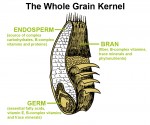 Addictive eating behavior and substance dependence have similar patterns of brain activity, finds a new study from the Rudd Center for Food Policy and Obesity at Yale. The study is published in the Archives of General Psychiatry and is the first to link symptoms of addictive eating behavior with specific patterns of brain activity in both obese and lean individuals.
Addictive eating behavior and substance dependence have similar patterns of brain activity, finds a new study from the Rudd Center for Food Policy and Obesity at Yale. The study is published in the Archives of General Psychiatry and is the first to link symptoms of addictive eating behavior with specific patterns of brain activity in both obese and lean individuals.
Previous research has identified similar patterns of brain activity in obese and substance-dependent people, which has led to the theory that some people may be addicted to high-calorie foods, but no previous studies have explored whether lean as well as obese individuals who exhibit symptoms of addictive eating behavior have neural responses similar to those of drug addicts.
In the current study, 48 healthy adolescent women ranging from lean to obese completed the Yale Food Addiction Scale (YFAS), which applies the diagnostic criteria for substance dependence to eating behavior. Next, using brain-imaging procedures such as functional magnetic resonance imaging (fMRI), the study examined the relation of food addiction symptoms, as assessed by the YFAS, with the women’s brain activity in response to food-related tasks. The first task looked at how the brain responded to cues signaling the impending delivery of a highly palatable food (chocolate milkshake) versus cues signaling the impending delivery of a tasteless control solution. The second test looked at brain activity during the actual intake of the chocolate milkshake versus the tasteless solution.
Both lean and obese participants with higher food addiction scores showed different brain activity patterns than those with lower food addiction scores. In response to the anticipated receipt of food, participants with higher food addiction scores showed greater activity in parts of the brain responsible for cravings and the motivation to eat, but less activity in the regions responsible for inhibiting urges such as the desire to drink a milkshake. Thus, similar to drug addicts, individuals exhibiting signs of food addiction may struggle with increased cravings and stronger motivations to eat in response to food cues and may feel more out-of-control when eating highly palatable foods.
According to Ashley Gearhardt, clinical psychology doctoral student at Yale University and lead author, “The findings of this study support the theory that compulsive eating may be driven in part by an enhanced anticipation of food rewards and that addicted individuals are more likely to be physiologically, psychologically, and behaviorally reactive to triggers such as advertising. The possibility that food-related cues may trigger pathological properties is of special concern in the current food environment where highly palatable foods are constantly available and heavily marketed.”
The authors assert that efforts to change the current food environment may be critical to successful weight loss and prevention efforts since food cues may take on motivational properties similar to drug cues. The current emphasis on personal responsibility as the reason for increasing obesity rates may have minimal effectiveness as palatable food consumption may be accompanied with a loss-of-control for individuals exhibiting signs of food addiction.
Source: Yale University

 We all keep hearing that we need to eat more whole grains, but does everyone know what they are? It's pretty obvious they are NOT that swishy white bread that we used to make dough balls out of when we were kids (to use for bait while fishing!). Whole grains are cereal grains that consist of the intact, ground, cracked or flaked kernel, which includes the bran, the germ and the inner most part of the kernel (endosperm). Examples of whole grains include whole wheat, oatmeal, whole-grain cornmeal, brown rice, whole-grain barley, whole rye, and buckwheat.
We all keep hearing that we need to eat more whole grains, but does everyone know what they are? It's pretty obvious they are NOT that swishy white bread that we used to make dough balls out of when we were kids (to use for bait while fishing!). Whole grains are cereal grains that consist of the intact, ground, cracked or flaked kernel, which includes the bran, the germ and the inner most part of the kernel (endosperm). Examples of whole grains include whole wheat, oatmeal, whole-grain cornmeal, brown rice, whole-grain barley, whole rye, and buckwheat. High-fiber diets during early adult years may lower lifetime cardiovascular disease risk
High-fiber diets during early adult years may lower lifetime cardiovascular disease risk
 The largest study of its kind has confirmed a strong association between overweight and obesity and an increased risk of death. The study also identified a range of
The largest study of its kind has confirmed a strong association between overweight and obesity and an increased risk of death. The study also identified a range of  People will gain significantly less weight by middle age – especially women – if they engage in moderate to vigorous activity nearly every day of the week starting as young adults, according to new Northwestern Medicine research.
People will gain significantly less weight by middle age – especially women – if they engage in moderate to vigorous activity nearly every day of the week starting as young adults, according to new Northwestern Medicine research.
 In a new meta-analysis published in the
In a new meta-analysis published in the  I just got back from a brief vacation in the Italian region of Emilia Romagna--the land of Parma ham, proscuitto, Pasta Bolognese and tasty hard cheeses. One of the regional specialties is a ravioli filled with spinach and ricotta covered in a butter sauce and sprinkled with parmesan cheese (Are your arteries choking yet?). I was immediately struck by the lack of overweight people despite these wonderful foods that are high in fat and quite salty. What is it about Italy that allows people to stay thin, yet eat these rich foods?
I just got back from a brief vacation in the Italian region of Emilia Romagna--the land of Parma ham, proscuitto, Pasta Bolognese and tasty hard cheeses. One of the regional specialties is a ravioli filled with spinach and ricotta covered in a butter sauce and sprinkled with parmesan cheese (Are your arteries choking yet?). I was immediately struck by the lack of overweight people despite these wonderful foods that are high in fat and quite salty. What is it about Italy that allows people to stay thin, yet eat these rich foods?
 Today,more than 200 health professionals attended the
Today,more than 200 health professionals attended the